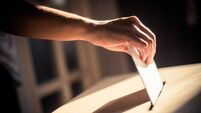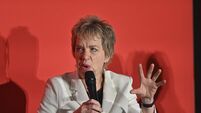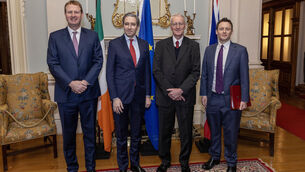Electoral Commission to explore mechanics of postal voting following election turnout

Electoral Commission CEO Art O'Leary said: If we want to make inroads into the 50% of non voters, it's lazy just to say some people can't be bothered to vote. Some people want very much to vote.' Picture: Moya Nolan
Ireland's election watchdog will report on expanded postal voting to the government this year, as it seeks to make voting more accessible.
Turnout for last month's general election fell below 60%, having hit nearly 70% in 2011, prompting much discussion of voter engagement.
However, Electoral Commission CEO Art O'Leary says that while the focus is on those who choose not to vote, more should be done to "make voting easier".
At present in Ireland, postal voting is narrowly available, with full-time members of the Defence Forces, diplomats posted abroad, and their spouses required to be registered as postal voters.
People are also eligible for a postal vote if they are a member of An Garda Síochána, if they cannot go to a polling station due to illness or disability, or if they are studying full-time at an educational institution in Ireland, which is away from the home address where they are registered.
On polling day, Social Democrats leader Holly Cairns was unable to vote for herself having just given birth, and it is cases like these that Mr O'Leary believes could be addressed by changes to the rules.
"In June (the local and European elections) over half of people who didn't vote said that they were away on the day, they had work commitments, or they had caring responsibilities. We don't make it easy for people to vote in this country. You have to turn up in a particular place on a particular day, in between the hours of 7am and 10pm. And if you can't do that for whatever reason, then you are not allowed vote.
Mr O'Leary says that the Electoral Commission is undertaking a research study into postal voting, though ultimately, it will be a political decision. Political sources said, however, it was unlikely that any changes would be made before October's Presidential election.
"If we want to make inroads into the 50% of non voters, it's lazy just to say some people can't be bothered to vote. Some people want very much to vote," Mr O'Leary said.
He said that holidays play a large role in turnout, pointing out that the local and European elections took place in the first week in June and that an emerging trend in November's poll was grandparents who had gone to visit children before Christmas. However, he ruled out making voting mandatory, saying that he was "all about carrot".
The Commission will next year focus on a campaign alerting 16 and 17-year-olds that they can pre-register to vote.
On the method of voting in Ireland, Mr O'Leary said that while he is a fan of the analogue system, there will likely be a conversation about electronic voting in the near future.
An attempt to move to e-voting machines is one of the most famous political debacles in Irish history. The ill-fated machines were bought by the Fianna Fáil government in the early 2000s but were scrapped in 2012 having been in storage for a decade. They were purchased by an Offaly-based recycling company for just €9 per unit, having cost €7,333 per machine to buy and store.
Mr O'Leary said that Ireland's democracy overall is "in rude good health".
"I would have thought people have confidence in the process and they trust the results. And that's the ultimate aim. It just so happens that we have a very manual process. Any departure from a process like that would have to be designed with great care to ensure that people would retain their confidence in it because the Irish people have got used to the system of voting. They've been asked on two occasions in the last 100 years whether they want to change the electoral system and have declined on both those occasions."
Mr O'Leary said that his body was keenly aware of the "Streisand Effect", a phenomenon of unintended consequences bringing more attention to little-seen content.
"If somebody posts something that two followers are going to see, and then we respond to it and say, 'this is preposterous, it's not true', then thousands of people get to see it. We're conscious of that.
"We counter it very simply. We tracked a ballot box from two days out from the polling day, right to the count centre. You can see it on our website to explain to people how this works."
Read More













